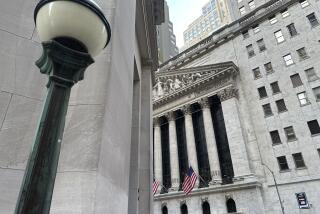Be Careful Boarding Bond Wagon
- Share via
How low can it go? No, not the stock market. The yield on the 30-year Treasury bond.
That’s the pressing question right now for many investors.
After several years of shunning bonds in favor of turbocharged stocks, individual investors poured an estimated net $8 billion into bond mutual funds last month, more than twice the amount they added a month earlier.
And after watching the so-called long bond dive below the psychologically important 6% level last week, investors are likely to plow even more money into the fixed-income arena in coming weeks.
That could prove to be a wise strategy if interest rates stabilize or head lower still. But small investors would also be smart to exercise a little caution, experts say.
Despite last week’s action, many experts doubt the rally can go much further without a move by the Federal Reserve Board to cut interest rates, which seems unlikely at its meeting today or in the near future. Normally, longer rates are higher than the Fed’s benchmark short-term rate, now 5.5%, although they have been less during recessions.
If rates reverse course and head back up even a little bit, investors could suddenly find themselves saddled with capital losses.
That would rekindle memories of 1994, when a series of Fed rate hikes unexpectedly slammed individual investors.
“I’m long-term bullish on the bond market, but we’ve come an awful long way for people to be jumping in now,” said David Horner, a bond strategist at Merrill Lynch & Co.
The benchmark 30-year Treasury pierced 6% on Thursday and closed the week yielding 5.92%, a four-year low. They backed off a bit Monday on strong economic data, ending at 5.97%.
Bonds got a big boost last week when a raft of companies, including technology giant Oracle Corp., said the deepening Asian financial crisis would crimp earnings. That raised the possibility that U.S. economic growth would slow noticeably next year.
But most data show the U.S. economy is still in fine shape, including a buoyant jobs report for November. On Monday, the Fed said factory output grew at its fastest pace in four months while plant use was at its highest level in 26 months.
Numbers like that have many on Wall Street convinced long rates won’t head much lower.
“We are nearing the limit on falling bond yields,” said Nanette Abuhoff, senior fixed-income strategist at J.P. Morgan Securities Inc.
To be sure, there are arguments in favor of bonds.
Yields, in fact, have been headed down since April, thanks to a variety of factors that largely remain in place.
The lower U.S. budget deficit means a smaller supply of new issues. Foreign rates have been low, thus drawing investors from abroad. And inflation has remained tepid despite a barrage of numbers throughout the year indicating vibrant economic conditions.
Perhaps most important at the moment, investors have huddled into Treasury bonds as a safe haven while the Asian debacle sorts itself out and the stock market does contortions. Bond enthusiasts say the worst-case scenario--a Fed rate boost--is especially unlikely now because it would jar already shaky Asian markets.
This is the third time since late 1993 that the long bond has broken below 6%. (The record low since the late 1970s was 5.79%, set on Oct. 15, 1993.) But the yield shot up quickly each of the first two times when investors got spooked by the notion of stronger growth.
Bond bulls say this time is different because there are deflationary currents, including falling prices for gold and other commodities.
“There are a lot of people who think that this time it’s the real thing,” said Joel Marver, a Treasury-bond expert at Technical Data, a Boston-based research firm. “There are people who are looking for sub-5% on the long bond.”
Bonds are a good buy because their real rate of return is favorable by historic standards, Marver said. That figure is derived by subtracting the inflation rate, now about 2%, from the 6% return on the long bond. That 4% spread is attractive compared with its past average of 3% to 3.5%, he said.
Bond bulls also believe the risks are far lower than in stocks.
“They’re still cheap relative to stocks,” said Bill Mikus, managing director of Mikus Capital Management, a Manhattan Beach investment advisor.
Investors drawn to bonds might want to stick to Treasuries, experts say. Because U.S. government securities are the safest investments, they carry the lowest yields. Other issues, such as corporate and high-yield bonds, pay more because they’re riskier securities.
But throughout the year, the spreads between Treasuries and other securities have been low by historic norms.
A 10-year, single-A-rated industrial corporate bond, for example, yields only about .60% more than a 10-year Treasury, said Steve Kane, a bond-fund manager at Metropolitan West Asset Management in Westwood. That means investors are being paid very little to take on the extra risk that the bond could fall into default.
“We view the Treasury market, and the bond market in general, as expensive,” Kane said.
(BEGIN TEXT OF INFOBOX / INFOGRAPHIC)
Sinking Yields
The yield on 30-year U.S. Treasury bond, at 5.97% on Monday, is nearing the lowest rate ever seen on those bonds since the government began regularly issuing them in the 1970s. Quarterly closes and latest:
Monday: 5.97%
Source: Bloomberg News
More to Read
Inside the business of entertainment
The Wide Shot brings you news, analysis and insights on everything from streaming wars to production — and what it all means for the future.
You may occasionally receive promotional content from the Los Angeles Times.










